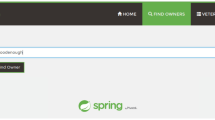Abstract
Interactive programming is a convenient programming style that supports fast prototyping and debugging but often results in a loss of modularity and security. This article addresses the problem of supporting reliable and modular interactive programming. A module system designed for interactive use is introduced. This module system supports separate compilation and automatic updating of module interfaces during program development. It also allows the programmer to obtain a fresh program state for reliable testing, eliminating the need to reload an entire program.
Similar content being viewed by others
References
Abelson, H. and Sussman, G.J. with Sussman, J.Structure and Interpretation of Computer Programs. MIT Press and McGraw-Hill, 1985.
Cardelli, L., Donahue, J., Glassman, L., Jordan, M., Kalsow, B., and Nelson, G. Modula-3 report. Technical Report 31, DEC Systems Research Center, 1988.
Curtis, P., and Rauen, J. A module system for scheme. InProceedings of the 1990 ACM Conference on Lisp and Functional Programming, 1990.
Davis, H., Parquier, P., and Séniak, N. Talking about modules and delivery. InProceedings of the 1994 ACM Conference on Lisp and Functional Programming, 1994, pp. 113–120.
Feldman, S.I. Make: A Program for Maintaining Computer Programs. Unpublished article.
Friedman, D.P., and Felleisen, M. A closer look at export and import statements.Computer Language 11(1):29–37, 1986.
Harper, R., Milner, R., and Tofte, M. The definition of Standard ML. Technical Report ECS-LFCS-89-81, Department of Computer Science, University of Edinburgh, 1989.
MacQueen, D. Modules for Standard ML. InProceedings of the 1984 ACM Conference on Lisp and Functional Programming, 1984, pp. 198–207.
Queinnec, C., and Padget, J. Modules, macros and lisp. InEleventh International Conference of the Chilean Computer Science Society, Plenum Publishing Corporation, 1991, pp. 111–123.
Rodríguez, R.G., Duba, B.F., and Felleisen, M. Can you trust your read-eval-print loop? Unpublished manuscript.
Steele G.L., Jr.,Common Lisp, The Language. Digital Press, Second Edition, 1990.
Teitelman, W., and Masinter, L. The interlisp programming environment.IEEE Computer,14(4):25–34, 1981.
Tung, S.-H.S.Merging Interactive, Modular, and Object-Oriented Programming. Ph.D. Thesis, Indiana University, Bloomington, 1992.
US Government Department of Defense. The programming language ADA: Reference manual. Lecture Notes in Computer Science, 1981, vol. 106.
Wirth, N.Programming in Modula-2. Springer Verlag, 1983.
Author information
Authors and Affiliations
Rights and permissions
About this article
Cite this article
Tung, SH.S., Dybvig, R.K. Reliable interactive programming with modules. Lisp and Symbolic Computation 9, 343–358 (1996). https://doi.org/10.1007/BF01806317
Issue Date:
DOI: https://doi.org/10.1007/BF01806317




